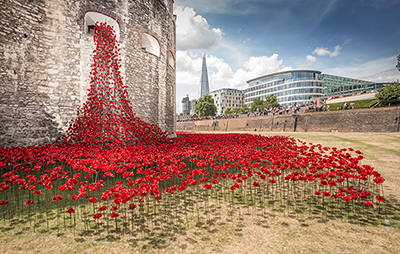|
Poppies in the Moat at the Tower of London by Paul Cummins and Tom Piper |
||
|
Paul Cummins’ installation is an example of how poppies have become a backdoor expression of a nationalism that might otherwise be unacceptable, says Edwin Heathcote Tower Hill is thronged with people. You can barely exit the tube station and announcements inside warn against using it at all. The cause? 888,246 poppies making the Tower of London’s moat into a carpet of red. This is installation art as populist spectacle, the tropes of the art gallery poured out into the public realm to mingle with mawkish sentimentality, charity and a jingoistic celebration of the armed forces. The installation, if we can call it that, is the work of ceramic artist Paul Cummins (whose oeuvre seems to comprise entirely of ceramic flowers, plus a few bowls with flowers on) and stage designer Tom Piper. It is, admittedly visually striking, but it is also unsettling for all the wrong reasons. All memorials are, inevitably, aestheticisations, but there is something about the ubiquity of the poppy as a prettification of one of the most gruesome conflicts of the modern age that galls. It chimes with a curious moment in the British popular imagination in which the people have turned on politicians, but seem to revere the armed forces in an unthinking way. The war wounded have become contemporary martyrs for a post-religious society and the poppies are the mass religious experience, the coming together in common cause, that society lacks in other fields.
The commemoration and celebration of the war dead has become a genuine bottom-up expression of popular culture. The huge displays of respect to soldiers returning as corpses at Wootton Bassett saw the unlikely line up of Hells Angels beside blazered-veterans and England-shirted football fans in a UKIP-ish display of nationalism. Other European countries are commemorating the war dead of all sides (a new memorial to all the Great War dead at Arras by architect Philippe Prost will be inaugurated by François Hollande, Angela Merkel and David Cameron on Armistice day), yet Britain persists with its own narrow, nationalist remembrance – a covert celebration of victory and superiority under the guise of “never forgetting”. There is something here of Guy Debord’s Society of the Spectacle, the substitution of the spectacular for the real. The media balks at showing bodies and the realities of war; instead we have its representation as a thing of beauty, a field of flowers. Debord writes of a society that prefers the sign to the thing signified, representation to reality. Through the medium of the art installation, the language of Ai Wei Wei’s hand-painted ceramic sunflower seeds, these poppies have become a backdoor expression of a nationalism that might otherwise be unacceptable: a glorification of war and sacrifice in the guise of sentimental memory. Just as it is inconceivable for a politician to not wear a poppy (he or she would be deliberately disrespecting the memory of the sacred dead, a cardinal sin), so this fake flower has become a cipher for a popular nationalism, a rebuff to Europe and a potent symbol of imagined glory. It is a freighted flower, a fake flower lost in a sea of simulacra. There is something unsettlingly fascist about this image of the individual subsumed into the field, the expectation of the poppy as a sartorial symbol of expected respect. If remembrance is enforced it becomes something else, a compulsory false memory. Adolf Loos famously asserted that only a very small part of architecture belonged to art, the tomb and the monument. Perhaps it is time to question whether a memorial like this – a fleeting borrowing from the tropes of installation, spectacle and the gallery floor – can ever really belong to art. Do you think that Paul Cummins’ poppy installation is a glorification of war in the guise of sentimental memory or a fitting memorial for the lives lost during the war? Respond using the comment box below |
Words Edwin Heathcote |
|
|
||




















